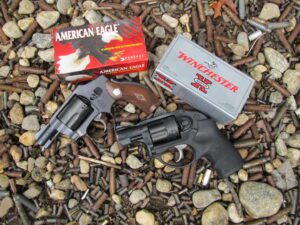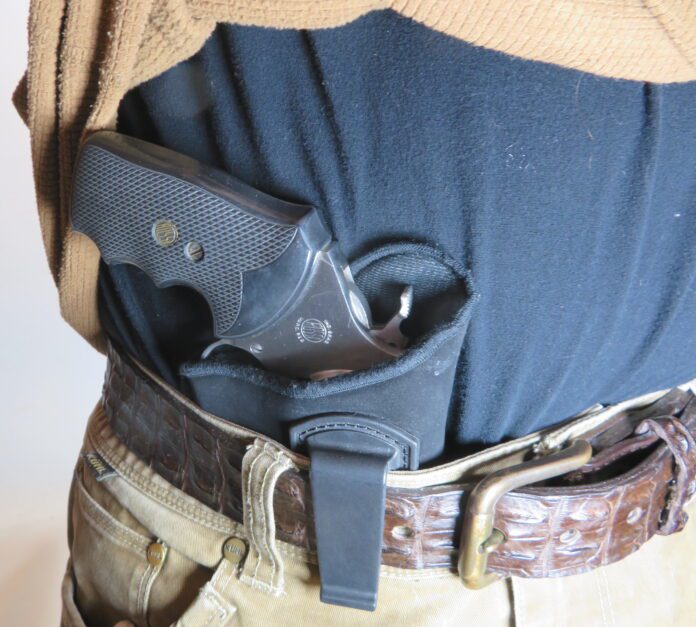Though most concealed-carry shooters prefer pistols these days, a cadre of knowledgeable, experienced self-defense aficionados prefer revolvers, sometimes referred to as wheelguns for the resemblance of the revolver cylinder to a rotating wheel. In fact, several Gun Tests team members carry revolvers instead of pistols, and have for more than 30 years. Why change something that is familiar and just continues to work?
One reason revolvers make good self-defense guns is that they are easy to use, basically requiring the shooter only pull the trigger to fire.
Also, revolvers are chambered in powerful cartridges like 38 Special and 357 Magnum, which are two of the most popular revolver choices for self defense.
Below, we look at a few more insights about the once-ubiquitous revolver as a self-defense choice and try to clear up some misunderstandings about its role as a defensive arm.
Are Revolvers Good for Conceal Carry?
Revolvers make an excellent concealed-carry firearm because some revolvers are small and compact and chambered in powerful self-defense calibers. Revolvers also make excellent concealed-carry guns because of the DA (Double Action)/SA (Single Action) trigger or DAO (Double Action Only) trigger. These types of triggers require a long, deliberate pull of the trigger to fire the revolver, and in a high-stress situation, a trigger that takes more effort to pull may prevent a negligent discharge.
Why Use a Revolver Instead of a Pistol?
Revolvers offer simplicity over many semi-automatic pistols. Revolvers have fewer moving parts and fewer operator controls, which means a revolver can be less likely to malfunction compared to a semi-automatic handgun.
With revolvers, a user just needs to aim and press the trigger to fire the handgun. With many semi-automatic pistols, a safety needs to be disengaged before aiming and pressing the trigger to fire the gun. Also, some safeties, such as those in mainspring housings, require a certain grip in order to make the gun ready to Fire.
Also, in the event of a misfire when shooting a revolver, a cartridge that does not fire only requires the user to press the trigger again. If a cartridge does not fire in a semi-automatic pistol, the user must manually tap the magazine to ensure it is seated and then rack the slide and perhaps do other clearance drills. The process is more complicated when shooting a semi-automatic pistol than it is with a revolver.
Plus, a revolver does leave empties scattered all over the ground.
What Are the Disadvantages of Revolvers?
Revolvers have slower reload times than semi-automatic pistols, and a wheelgun has limited capacity compared to most pistols.
With a revolver, the user needs to open the cylinder, called swinging out the cylinder, to eject empty cartridge cases and load a fresh cartridge into each chamber. The process takes longer than swapping magazines in a semi-automatic pistol.
Round capacity can also be seen as a disadvantage of a revolver, but not necessarily. Most centerfire revolvers hold 5, 6, or 7 shots, where pistols may carry twice those round counts, or more.
When you look at a typical self-defense scenario, only 3 to 5 shots are typically fired, according to FBI statistics. If you think you are undergunned with a revolver, you likely are not.

Why Do People Carry Revolvers?
Some with concealed-carry permits choose a revolver because it is effective for everyday carry. Revolvers are simple to use, simple but slow to reload, and are chambered in powerful cartridges that are effective in self-defense situations. Also, they may be fired from inside a pants or jacket pocket, and they won’t be knocked out of battery in the event something presses on the muzzle.
Revolvers do not have manual safeties, decocking levers, and magazine-release buttons that can complicate operation.
So revolvers are examples of the K.I.S.S. principle: Keep It Simple, Stupid. When the time to stop an aggressor has come, the wheelgun is simple and fast to bring into action. That’s a pretty good reason for carrying one.




























First and foremost: I don’t care what anyone carries so long as they practice with it and actually have it on them.
That said, there’s only one or two scenarios where a pistol is a worse choice than a revolver. Those are firing through clothing, or tussling/ contact shooting.
Revolvers are harder to fire accurately in DA, due to heavier trigger pulls. Follow up shots are also slower for 99% of shooters.
If you like revolvers, fine. I don’t care much about what handgun someone uses so long as they’re willing to train with it.
And ‘simpler’ argument is invalid as most striker fired pistols (Glocks, et al) also lack an external safety. Likewise reliability is a wash so long as you select a good pistol. Revolver malfunctions are actually harder to deal with and clear as opposed to most pistol problems.
Recoil is heavier out of revolver as opposed to slide operated pistols. The blast around the cylinder can be a hazard to those firing two handed with an imperfect grip.
If you carry a handgun, you are better served in almost every way to select a good pistol over a revolver. But pistols are a better choice for self defense.
Disagree. Pistols are superior only with respect to capacity and reloading. Revolvers don’t require hand strength to rack slides, can use ammo ranging from wad cutters to magnum calibers, and are amenable to use by family members of variable experience. Pistols such as Glocks do have a point-and-shoot capability but have been shown to be demonstrably less safe than revolvers. In more than 50 years of shooting I have never experienced a revolver failure. My pistol failures have been few, but not zero.
I’ve been shooting 15 years and I think both double action revolvers and striker fired autopistols are the most user friendly handguns for the average person. Both require only one to load and fire when ready. Both are mechanical devices like any other gun and can fail and I have seen both types fail before, and I think the issue of complexity of a handgun came down the pike with guns like the double action/single action autopistols because they had two types of trigger pull and remembering to decock the pistol when one was finished shooting or if one had left the safety on after reholstering, it required one to remember they have to disengage the safety in order to fire the first round double action. So I think the advent of the striker fired autopistol gave the autopistol the simplicity needed to make it user friendly. Either the double action revolver and the striker fired autopistol would be my choices for a self defense handgun.
I’am sorry, my inglisch is not so good!
My woman and y are shooting over more than 30 years whit smith and wesson 686 she standert and y whit a racing gun full tuned. Y reload my ammo and we have les problems then whit my cold coverment pistol! Revolvers are quick to reload cardridges whit the use of speedloaders, and the tricker can be tuned so its lighter!
And also too reload ammo its less dificult for an revolver then for pistol and you can shoot a diverend ammo whit revolver even 9mm ammo whit the right tool!
We loved oure smit and wesson’s
Again, sorry for my inglisch its a long time a go to use, i’m working on it!
I too am a fan of the 686. Mine is a -3 with a 6″ barrel. A buddy i shoot with has a Mahurin MR73and we both like each other’s revolvers. They are that close to shoot which surprised both of us. Main difference is he spent 3x as much for his MR75. That said were i not retired now and out of the workforce and the budget permitted i too would have a MR73 just because i could but i am very happy with my 686.
Is the Taurus Model 66 available in 4 inch barrel? Is it legal in California?
Is Taurus Model 66 available in 4 inch barrel?
Is it legal in California?
I am looking at a revolver after practicing with a semi-automatic pistol finding it impossible to flip the lever do to arthritic thumbs